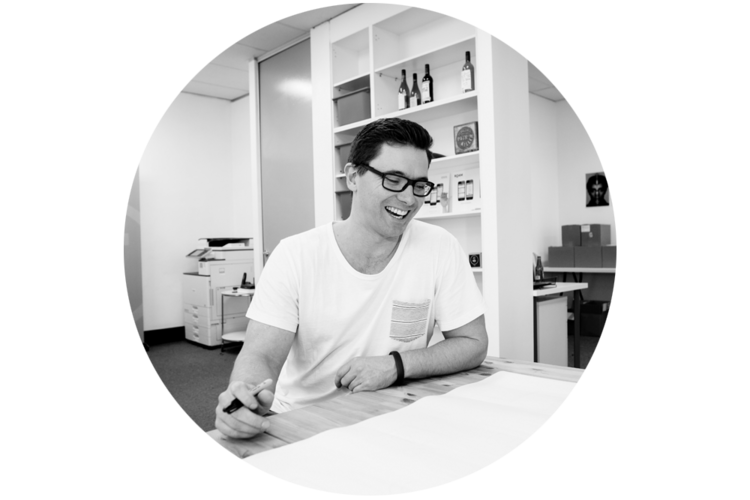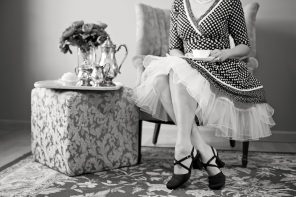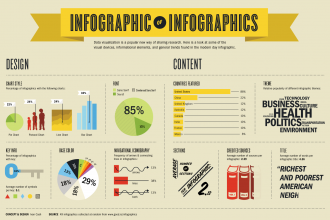Creative communities all over the world are expanding and facilitating new and improved aspects of making sure that the community’s creative faculties are not hindered by a lack of challenging and invigorating projects and opportunities. In our increasingly mechanized one-track framework of everyday existence, while it is quite easy to succumb being a one track pony and to continue with the same set of work and opportunities, there are innumerable initiatives which ensure that the creativity of our massively talented and unique set of creative personnel is not lost on lackluster opportunities or in a lack of inspiration.
One of the many initiatives which ensure such facilitation is the widely popular Creative Mornings breakfast lecture series, which has its chapters in various cities across the world. We got to interview the insanely creative and host of Creative Mornings Sydney, Flyn Tracy for an exciting talk about the various factors behind making Creative Mornings in Sydney successful, his other projects which facilitate the graphic designing community to better creatively fulfilling opportunities, and the overall experience of hosting events and lectures which have wildly inspiring speakers.
Tracy is also involved with projects such as the Tractor design school, which gives graphic designers a platform to get professional development and experience from one of the top studios in the country. They help facilitate challenging and rewarding projects which would genuinely reflect industry practice. Tracy mainly works with facilitating the programs, including promoting the courses, running interviews, and liaising with the industry (as well as taking out bins, as he mentions in the description in his blog).
How It All Began
He started out as a graphic designer, getting into the industry first purely as the designer and then expanding his base and experimenting and trying new things, as he said in the interview. ‘I’ve done lots of different things. I started with graphic designing, but I fell into it.’
Most creative people, you know they (did) drawing and stuff like that in school and had a passion for that; I did that stuff but I wasn’t really into it.
Tracy did his education from Australia, studying graphic design as his major, something which he said his mother had insisted upon. “I fell into graphic design; my mum made me study it…I didn’t really want to do it but she was going to keep me out if I didn’t study anything.” Something fairly extraordinary, seeing that most parents would and do encourage their children to pursue the more traditionally ‘safe’ career options such as engineering, and other such professional courses.
When we posited that to Tracy he simply admitted that he had ‘no idea, no idea’ as to why his mum insisted on graphic designing, but he laughingly admitted that, “Oh yeah I didn’t have the marks to become an engineer or a doctor.” After about six months of being in a program that he had initially not been intrigued by, things started to ‘click’ for him. “People kind of don’t get it, and then one day you just get it? And then you start getting really passionate about it. Some people, they just come in for graphic design and they know that that is what they want to do.”
Other people, they might be graduated, or in the industry, and then it clicks; but everybody has that kind of clicking point in their lives… For me, that was about six months in… Once I made the decision of sticking with the course, I started to put in more work in my projects… When the teacher would say this is the most important part, I was like ‘yeah yeah’ and did my own work. I guess that is when it started clicking for me.
Tracy got a job right out of school, and started working for a branding company, with whom he worked on a contract, following which he decided to go backpacking around Europe with his best friend. For about eight months he had no access to the design tools and hadn’t carried a laptop with him. “I was young and cocky; I told myself that I’ll get any job I want when I come back. I was wrong. I hadn’t looked at a computer screen for that amount of time (when backpacking in Europe) so I had to learn the tools again, but I didn’t have a mentor so I was basically doing really bad design work.” He worked a number of small administrative jobs due to his lack of being able to procure a designing job.
Working and Networking
He eventually ended up working for a school called Macleay College, a business school, and got involved in the education sector, jokingly calling it “ironic, because (I was a) terrible student.” Tracy then networked with the people marketing courses from other design schools and companies, eventually ending up befriending people and getting a job from one of the firms, doing design work for them as well as marketing their courses. He continued to work for the firm and got involved in a lot of other work and activities for them, before ending up helping to start the Tractor Design School, about five and a half years ago.
We asked Tracy what Tractor is really about, the management of a firm and a design school like that which focuses on enabling the design community engage in much more creative opportunities and projects. Tracy is currently the Industry Program Manager at Tractor but he admits that he has had a lot of other titles and job profiles within Tractor.
Tractor is basically an Industry Design School. It’s all about stints in graduates who are seriously ready for the industry…a lot of people and schools talk about that, and even though we have lots of people who are talented and completely across their education…but our heart and soul lives in industry graphic designers.
Tracy talked about their staff, the zealously passionate people who comprise of the faculty in Tractor and whose ‘heart and soul lives in producing people that fit industry’. As Tracy explains, Tractor helps in “…making sure that our students do not have a gap. A lot of schools tend to focus on education and marks and major projects, as well as burdening the student with schoolwork, and then there’s a gap; for some it lasts for a year or so, and for some more than three years or so. The widely held belief that one needs experience before getting into the job market tends to create the gap between students who have completed their education and them being a part of the design industry.
The removal of the gap and embedding of experience within their courses is what Tractor aims to achieve. They also have industry advisers and partners, which keep them up to date with the changes taking place within the industry which they then incorporate within their course structure, thus enabling it to be flexible and in with the times of the emerging and ever changing design industry. Therefore, as Tracy mentioned during our talk with him, Tractor doesn’t incorporate the traditional or old course in the times of the new, but rather comes from a different direction altogether.
All About Creative Mornings
Talking about Creative Mornings, Tracy admits that Creative Mornings “didn’t happen to me, I had to make it happen; it was a pretty tough one.”
Creative Mornings, for anyone reading who doesn’t know, is a global thing. So there are about a hundred and seventeen in the world, I think, and growing about three chapters a month. To start one of your own there is a sort of application process, and we were chapter twenty-two.
‘The application process was pretty brutal; I was thinking about doing it, was talking to friends about doing it, but wasn’t really doing anything about it, you know.” He said, when expostulating on the beginnings of the Creative Mornings chapter in Sydney, and it wasn’t until he partnered with Maria Guidera that the project and applications started to take shape. He advertised someone to help her with the application process, and what Tracy and Guidera decided was to get through with the process real quick; they had been talking about it but they hadn’t really done anything. “Quick for me was a couple of months; and quick for her was this weekend,” he says.
He admits that Guidera’s speedy deadline helped when they got together one Saturday and decided to get it over with. The application process included basically a video stating why they wanted to do the chapter which, as Tracy laughingly admits, “is still out there somewhere, (and) is quite embarrassing”. The application process also included a written application as well as stating a plan as to how they would fund the series, as every Creative Mornings chapter needs to be self-funded. Tracy talked about the business model which he and Guidera designed over the weekend as well as shooting the video and sending it with their application by the Sunday of the weekend.
We knew that there were a lot of people out there trying to do the same thing, so we got our work done quickly. We’ve been hosting a Creative Mornings every month since.
Marie Guidera left after about six months of being associated with the project, and it has been going on for the past four years now. Tracy told us about running the project along with a helpful and ‘awesome’ team of five organizers on a volunteer basis, hosting talks and garnering participants across Sydney and Australia. Seeing as to how there’s a sort of revolution of sorts happening in the creative field in various cities in India as well, we asked Tracy if he would recommend a Creative Mornings venture in a city. “Absolutely,” he replied. “It’s a great platform to network and make friends and it has been beneficial to me in a lot of ways. It definitely takes its toll, because at first its exciting and its fun, and you have all the energy.”
You think about when you are having a really bad week, and/or a month, you still kind of have to do it; the show has to go on. You have to put on a good show.

For The Creative Inside Us
Talking about how a change of surroundings and circumstances changed him or contributed to a change in his creative faculty, Tracy talked about his experiences working outside of his comfort zone and how it affected him. “I was working in Korea for a while and it was a life changing experience. I didn’t have a great time there, sort of considered coming home after the first three months, but I stuck it out and stayed there for six months. Backpacking was a lot of fun, though, and it’s good to see other cultures and other people and kind of expand your mind.”
When asked about how Australia had contributed to his creative aspect, Tracy took a moment and then agreed that it did. “A lot of work that I do revolves around promoting Sydney and Australia creators, so I think that its important to have a sense of pride about where you’re from. For example, in the design world a lot of the stars, like the Brad Pitts of the industry, would be working alongside you. Same in Delhi where I’m sure you’ll find all these creative people who would be working right next door to you and there will be a lot of people doing interesting things that you don’t hear about. That’s one of the things that drives me. It gives a platform to creative professionals who hadn’t gotten an opportunity before to showcase their work. It’s almost patriotic, it’s like ‘hey there, look, we’re doing cool stuff too!”
Talking about creative professionals hitting the glass ceiling in their own city before moving to the more industrially popular cities such as London or New York, Tracy insists on the building up of a creative community so as to enable and help everybody in the long run, a sort of long term plan, but nonetheless, one which is attainable.

The Stuff No One Tells You
A typical day for Flyn Tracy would be commuting from Alexandria, which is about ten minutes away from his workplace thus allowing him to sleep in, on his BMX to work, and then spending the rest of the morning focusing on his emails. While it may sound boring, Tracy admits a lot of his work consists of sending corresponding with industry personnel via email so that they know what they are going to be teaching or talking about as well as making sure that the content is suitable for the people who are going to be listening and learning from it. The rest of his day is spent with a couple of meetings, but is mostly centered around Tracy working by himself for the industry programs, podcasts that need to be recorded in the day and some Creative Mornings stuff. Evenings are spent attending the industry lectures, if taking place at that time.
When asked about whether or not he has taken any risks in his career, Tracy admits to taking a huge financial risk when he left a well-paying and steady job at a design school to work on building Tractor. “Tractor didn’t even exist then, even the name hadn’t been confirmed, really, and yeah, I quit. Quit my well-paying job to do that. I did that for two years with literally no pay.” Bills were paid for through some savings which he had set aside, Tracy admitted. While he is not one of the founders of Tractor, Tracy was their first employee, and their only employee for two and a half years.
Had Tractor not worked out, I would’ve been back to square one with no money. It was a huge gamble, and a lot of people thought that it was a really bad idea.
He admits that if he had known it would’ve taken that long, he wouldn’t have done it, “but I am glad that I did it.” Tracy admits though that he is too afraid to go back in time, because then he doesn’t think he would’ve done it. “I wouldn’t be in as good a place as I am now, but I am glad that its done and I’m proud of it now.” He feels that it was the right time, considering the fact that he didn’t have a huge financial burden. To everyone who might be in a similar situation of considering the future for their prospects, he says, “If you do not have kids or a financial burden of sorts, or if you don’t have huge loans, then definitely take risks, because you don’t actually have that much to lose.”
When we asked Flyn whether he thought he was creatively satisfied, he admitted that this was a tough question for him. “If you would’ve asked me three months ago, I would’ve said yes. To be honest, today, probably not, but I’m changing that.”
I think, a lot of what got me excited, I’ve gotten really used to it and I’ve gotten quiet.
“My issue,” he admits, “is that I have work with some of the most creative, influential, amazing people around, and that’s amazing for me, but it can affect you in the ‘I’m not doing something creative, I’m just watching other people do the creative and really interesting and exciting projects, and it’s great!'” The aftermath of this, he admits, is the harder part. “They go off, and I have to get back to my emails, but I’m in the process of changing that for the next year.” Creative stuff, he says, has to happen in the after hours and then one tends to run out of energy. “I don’t call myself a designer these days because I am not designing during the day. When I am designing, I am a designer but when I am answering emails I am not a designer. It’s relative, it’s just what the term means to me, and it means something different to everybody.”

Tracy ended the interview talking about the possibility of various global opportunities in the creative field, and the importance of it. “At the end of the day, you would want to be doing something that you like. I think being in the creative side is much safer than being in any sort of a manual situation. For me, personally, I would rather be designing, say, an app rather than developing it, because over time that is going to get easier and would not require as many people, but designing it, the human element of it, that’s something you cannot take out of it.” Although he admits that he would’ve moved to Melbourne in a heartbeat because of the opportunities and the people and industry there, he admits that Sydney is where it all started, it is where Creative Mornings is based and where his partner is. “Sydney is home,” he admits, before closing the interview.













